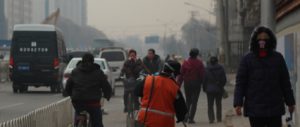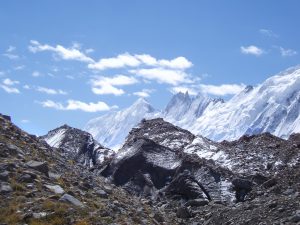It’s a beautiful day in Beijing. That’s to say, the sky is a greyish blue and it doesn’t feel like dicing with death to go outside without a face mask. Steven Q Andrews, an environmental consultant and author of an explosive piece of research that shines a light on failures in Chinese air-quality assessments, published on chinadialogue last week, points out that only in this city does air like this feel “amazing”. These days, Beijingers celebrate when they draw the curtains in the morning and can see the tops of the skyscrapers.
In fact, on the day we meet for a winter hot chocolate in one of Beijing’s upmarket international hotels, fittingly located behind the headquarters of Shenhua Group, China’s largest coal producer, the air quality is only “moderate”, says Andrews. But it’s an improvement: the previous 48 hours saw the city shrouded in a thick, toxic smog that grounded flights, stopped traffic and triggered record business for face-mask merchants.
It also prompted an outcry from a public whose patience with health risks and fudged government statistics – which class most days as “blue sky days” and exclude data on ozone and fine particulates – has worn very thin. The angry voices on microblogging sites like Sina Weibo are hard to miss. “We firmly demand that Beijing’s environmental protection administration starts at the least publishing PM 2.5 levels in certain areas within 2012! Otherwise provide all Beijingers, including the transient population, with gas masks!” wrote one NGO worker, Guo Xia.
Meanwhile, China Daily has issued warnings about lung cancer rates and even the nationalistic Global Times ran a leader concluding that the debate over pollution levels has become “a matter of government credibility” and is an argument “the government can easily lose”.
It’s this credibility question that propelled Andrews’s research into the centre of the debate. He analysed data provided by an air quality monitor atop the United States embassy and compared them with statistics reported by Beijing’s own Environmental Protection Bureau (BJEPB). The results are far from a ringing endorsement of China’s efforts to improve environmental transparency: while city officials have reported “good” or “excellent” air quality almost 80% of the time over the past two years, the embassy data indicates air has been “hazardous” more often than good. (Read his full analysis here.)
“What’s so outrageous is this whole story that air pollution in Beijing has gotten so much better, when it hasn’t,” says Andrews, a law-school graduate from the United States who has set up home in Beijing. “Every single year since they started this public reporting in 1998, the number of blue sky days has increased: 2009 was 285 days, then [in 2010] it was 286. This year, as of the end of November, they were four days short of where they were last year. So they are going to have to make up four days – and my guess is that they will. But people know that the pollution isn’t getting better.” (It should be noted that BJEP’s official air-quality reporting website does not use the term “blue-sky days”, instead classifying air quality as “level one” or “level two”.)
Since publication of his report, Andrews has been busy fielding calls from Chinese newspapers (as have chinadialogue staff, who were taking requests for his contact details until 11pm on Wednesday). And the interest is not restricted to China: Andrews has been interviewed by the BBC and Bloomberg News and his report cited in The New York Times, The Atlantic, The Guardian and Time, among other publications. It’s not his first challenge to BJEPB on the international stage. In the run-up to the 2008 Olympics, Andrews published a similarly provocative article about massaged pollution statistics in The Wall Street Journal, research that was also covered by scientific journals Science and Nature.
Some researchers disagree with Andrews’s stance. Angel Hsu wrote on chinadialogue recently that China’s planned tightening of air quality metrics in 2016, when it plans to start publishing PM 2.5 data, is part of a broader shift “to a political culture that is more open about environmental conditions.” And, perhaps unsurprisingly, officials at the city’s environment watchdog are unwilling to accept his findings, not least vice head of the municipal environmental protection administration, Du Shaozhong, an official who once famously tried to quash concerns about Beijing’s air pollution by pointing out that: “when you are taking a bath in the bathroom, you are unable to see the person opposite. It does not mean there is pollution.”
This week, as well as working to calm frayed public tempers on his microblog, Du has publicly denied one of the most striking assertions in Andrews’s article: that BJEPB stopped using data from its two most polluted air-quality monitoring stations in 2006.
When pressed on this by chinadialogue, Andrews produces reams of evidence from official archives to support his claims. What government documents and the data sets themselves show, says Andrews, is that, from 1998 to the end of 2005, the bureau was using daily reports from seven monitoring stations to produce “the only number that really matters”: the one used to calculate the number of blue sky days and average pollution concentrations for the city.
In 2006, while the bureau continued to report data from all seven of these stations, it stopped using figures from the two most polluted spots, Qianmen and Chegongzhuang, in its calculations. At the same time, it added three new sites, located further away from roadways than the two that were now – to all intents and purposes – defunct. In 2008, daily reporting from these two locations ceased altogether, and the authorities added three new monitoring stations in the, significantly cleaner, suburbs. (BJEPB admitted back in 2008 that it had moved monitoring station locations, though it denied any intention to deceive.)
According to Andrews’s calculations, the effect of these changes has been to inflate “blue sky” statistics and depress pollution concentrations, with impacts that go far beyond government rhetoric: “Some people make the point that the blue sky days is a policy relevant metric, that it’s not scientific,” says Andrews. “But these annual average concentrations are used in studies that have huge impacts, for example calculating the health and economic impacts of pollution. They’re numbers that are being used beyond the government – by the scientific community, the medical community, to assess the severity of pollution.”
Others point out that changing monitoring arrangements within a city is not always cause for concern. Wei Fusheng, a professor at the Chinese Academy of Engineering and formerly chief engineer at China National Environment Monitoring Centre tells chinadialogue: “It may indeed be the case that certain, particularly polluted monitoring stations were removed, resulting in an apparent improvement in air quality. But generally speaking, when there are adjustments in monitoring stations, there is a process that means the data can still be compared with previous years. This means a situation like this one should be avoided. But it’s possible that sometimes it isn’t.”
According to Wei, moves like this aren’t necessarily a deliberate attempt to collect cleaner data. “Our city is expanding outwards into the suburbs, and so is our pollution. The decision to install monitoring stations in the outskirts is driven by urbanisation in these places, and the desire to collect data that better represents the wider area.”
In addition, Wei points out that, even if monitoring stations are static, the pollution around them will not be: “Pollution sources are constantly changing. For example, we used not to have so many cars, and so monitoring stations that recorded low figures in the past may now produce higher numbers. Or, if a particular monitor was located near a polluting factory and the factory later moved, data from that station may show a downward trend.”
Normal practice, he says, is to keep monitoring stations back from the road, so as not to distort the data: “The pollution situation is affected by traffic flow. The normal rule is that a monitoring station should be installed 50 metres to 100 metres away from a roadway in order to accurately represent an area’s situation and avoid too much influence from pollution local to that particular monitor.”
But for Andrews, the glaring fact remains that these changes have distorted year-on-year comparisons of air quality. He believes the distortions are driven largely by a target culture in which evaluation of officials’ performance is linked to meeting mandated goals from above. He’s keen to point out that environment officials are hardly likely to be in love with pollution themselves. Du, for instance, has a reputation for personal responsibility – reportedly choosing to walk a long way to work and encouraging others to take personal actions to care for the environment. “These people live in Beijing, they know how bad it is,” says Andrews.
But there is a serious question mark over the power that environment officials can wield. Their limited clout is demonstrated aptly in a November China Daily article about BJEPB attempts to enforce regulations on construction dust, thought to be responsible for around 40% of dust particles in the air and one of the city’s three main pollution sources, along with coal burning and vehicle emissions. It reads almost like a parody of ineffective governance: 17 building sites were inspected and none found to be complying with the rules on covering up dust. They were given three days to comply. Sites inspected three days later had made no changes. With no right to enforce laws – only to supervise – the department could do nothing to punish the violators.
It’s failures like these that anger Andrews the most. “The pollution levels are so shocking. And when there are such simple things you can do, it’s truly outrageous that the government isn’t taking what I call very rudimentary steps.” In the case of construction sites, he points out, there is no question of factories closing: “all they have to do is cover these dirt piles.”
But Andrews’s dogged focus on China’s air pollution data is fuelled by more than bewilderment at Chinese government inaction; he also understands that the issue transcends national borders. “I care about Beijing air quality because I live here, but also because US companies and US consumers are responsible, to some extent, for the pollution,” he says. “We all bear some responsibility for Chinese pollution.”
Meanwhile, Wei Fusheng says that the Beijing government’s conclusion that air quality has improved rests on measurements of sulphur dioxide, nitrogen dioxide and PM10. But levels of PM2.5 – the finer and more dangerous particulates – have been increasing in recent years, according to figures from a unit of the BJEPB which is already monitoring this pollutant, he says. PM 2.5 may be the bureau’s ticking bomb.
Olivia Boyd is assistant editor and Meng Si managing editor at chinadialogue.



